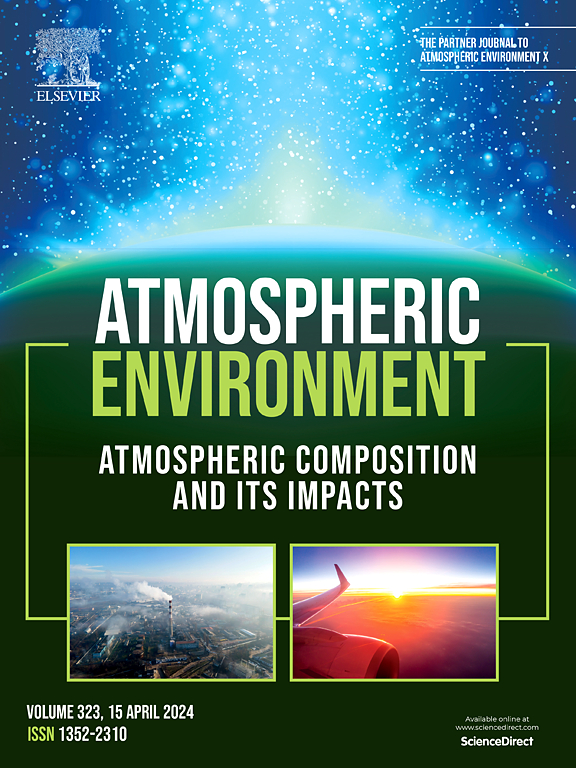揭露排放:追踪印度燃煤电厂周围的有机气溶胶
IF 3.7
2区 环境科学与生态学
Q2 ENVIRONMENTAL SCIENCES
引用次数: 0
摘要
在可预见的未来,燃煤火力发电厂(TPP)预计将成为印度的主要能源来源。它们的持续运营和计划扩建将增加排放,进一步降低印度恒河平原的空气质量,破坏长期可持续性。在这项研究中,我们在一个超类别TPP的上风和下风地点收集了一年的颗粒物(PM2.5),并分析了多环芳烃(PAH)、正构烷烃和左旋葡聚糖。PM2.5的年平均值约为印度国家环境空气质量标准(NAAQS) (40 μg/m3)的2.5倍,是世界卫生组织标准(5 μg/m3)的40倍。苯并[a]芘的年平均浓度是NAAQS水平(1纳克/立方米)的5倍多,是欧洲环境局参考水平(0.12纳克/立方米,假设可接受的额外终身癌症风险为10万分之一)的40倍。诊断性多环芳烃比值和正构烷烃指标为主要排放源。正构烷烃主要来源于岩源,而多环芳烃主要来源于热源。左旋葡聚糖表明冬季和季风后生物质燃烧更多,下风农村站点的排放量高于逆风郊区站点。我们还使用了反向轨迹建模,包括聚类和浓度加权轨迹,来识别排放热点。他们发现,由于TPP排放,苯并[a]蒽、苯并[b]荧光蒽和二苯并[a,h]蒽水平升高。本文章由计算机程序翻译,如有差异,请以英文原文为准。

Unmasking Emissions: Tracing organic aerosols around a coal-fired power plant in India
Coal-fired thermal power plants (TPP) are projected to be a major energy source in India for the foreseeable future. Their continued operation and planned expansion will increase emissions, further degrading the air quality in the Indo-Gangetic Plains and undermining long-term sustainability. In this study, we collected for one-year particulate matter (PM2.5) at an upwind and downwind site from a super-category TPP and analyzed polycyclic aromatic hydrocarbons (PAH), n-alkanes, and levoglucosan. The annual mean of PM2.5 level was about 2.5 times the Indian National Ambient Air Quality Standards (NAAQS) (40 μg/m3) and 40 times the WHO standard (5 μg/m3). The annual mean of benzo[a]pyrene concentration was over five times the NAAQS level (1 ng/m3) and 40 times the European Environment Agency reference level (0.12 ng/m3, assuming an acceptable risk of additional lifetime cancer risk of 1 in 100,000). Diagnostic PAH ratios and n-alkane indices indicated the primary emission sources. n-Alkanes were mainly derived from petrogenic sources, while pyrogenic sources were the main contributor to PAHs. Levoglucosan indicated more biomass burning during winter and post-monsoon, with higher emissions at the downwind rural site compared to the upwind suburban site. We also used backward trajectory modeling, including clustering and concentration-weighted trajectories, to identify emission hotspots. They revealed elevated benzo[a]anthracene, benzo[b]fluoranthene, and dibenz[a,h]anthracene levels due to TPP emissions.
求助全文
通过发布文献求助,成功后即可免费获取论文全文。
去求助
来源期刊

Atmospheric Environment
环境科学-环境科学
CiteScore
9.40
自引率
8.00%
发文量
458
审稿时长
53 days
期刊介绍:
Atmospheric Environment has an open access mirror journal Atmospheric Environment: X, sharing the same aims and scope, editorial team, submission system and rigorous peer review.
Atmospheric Environment is the international journal for scientists in different disciplines related to atmospheric composition and its impacts. The journal publishes scientific articles with atmospheric relevance of emissions and depositions of gaseous and particulate compounds, chemical processes and physical effects in the atmosphere, as well as impacts of the changing atmospheric composition on human health, air quality, climate change, and ecosystems.
 求助内容:
求助内容: 应助结果提醒方式:
应助结果提醒方式:


